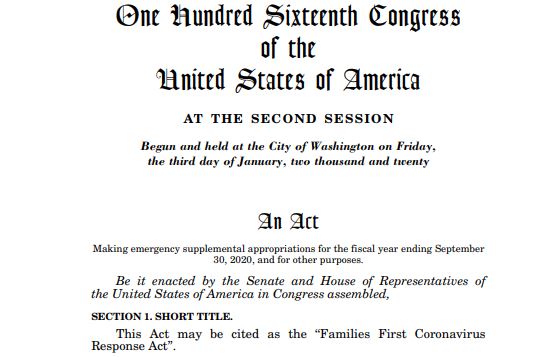
The Families First Act became effective April 1st and was signed into law on March 18th. It essentially pushes the requirements of FMLA (Family and Medical Leave Act) down to all small business, including those with 50 or fewer employees.
From April 1 to December 31, 2020, small employers will be required to provide employees with up to 10 weeks of paid FMLA. The first 2 weeks may be unpaid leave. Which employees qualify? Those employed for at least 30 days who must care for children whose school has closed. The employee is not be able to telework as a result of childcare responsibilities.
Employers may be exempt from this FMLA expansion if they can prove providing the leave would endanger the business to the point of going out of business. Businesses with more than 25 employees must reinstate employees when they return to work.
In addition to the FMLA expansion, there is a provision called the Emergency Paid Sick Leave Act. From April 1 to December 31, 2020 small business must provide paid sick leave to those meeting the criteria of being unable to work at the business or remotely because:
- They are subject to federal, state or local COVID-19 quarantine
- A doctor has advised them to self-quarantine due to COVID-19
- They are experiencing symptoms of COVID-19 and are seeking medical diagnosis
- They are caring for a family member who is under quarantine
- They are caring for children whose school has closed or the caregiver is not available due to COVID-19
- Other conditions according to the Secretary of Health and Human Services
A full-time employee caring for a child under the provisions listed above, is eligible for up to 12 weeks of leave – 2 weeks paid sick leave with 10 weeks of paid expanded family and medical leave. Part time employees are eligible for leave the same as the number of hours they would normally work.
A full-time employee in one of the other categories meeting one of the other criteria listed above is eligible for 80 hours of leave and part time employees are eligible for the number of hours they would normally work.
There are additional rules for those categorized as a Joint Employer. The Department of Labor released the final rules on January 16, 2020 with an effective date of March 16, 2020. The Department of Labor released a Small Entity Compliance Guide with examples of Joint Employer relationships.
That is a lot of unexpected expense for a small employer. As part of the Act, Congress provided for various tax credits to help small employers pay for the additional benefits. The U.S.Chamber of Commerce has published an Employee Retention Tax Credit Guide.
Payroll Tax Credit FMLA – Provides for a refundable tax credit equal to 100% of qualified family leave wages. The credit is against the employer portion of Social Security taxes and is claimed as part of the employer’s quarterly tax return. The credit is triggered after the employee takes 10 paid sick days. There are other provisions to this credit so speak with your CPA or tax expert.
Self-Employed Individuals FMLA are eligible for a 100% tax credit for qualified family leave equivalent amounts. It is creditable against income taxes and applies to those who would qualify for the Families First Act leave if they were an employee. The IRS will require self-employed individuals to provide documentation of their eligibility.
Payroll Tax Credit for Paid Sick Leave allows an employer to get a refundable tax credit worth up to 100% of sick leave wages paid each quarter. The credit is against the employer’s portion of Social Security Taxes paid. The total number of days per employee may not exceed 10 days over the total number of days in preceding calendar quarters. There are other provisions to this credit, so consult your CPA or tax expert.
Tax Credit for Sick Leave – Self Employed Individuals may claim a refundable tax credit up to 100% of qualified sick leave equal to that provided to employees who must self-isolate, obtain a diagnosis, or comply with isolation recommendations.
Self-Employed caring for a family member or child receives a credit equal to 67% of the qualified sick leave amount. Eligible persons are those who would qualify under the Act if they were employees. The Self-Employed will be required to provide documentation to the IRS.
This legislation also provided for free COVID-19 testing by insurers, Medicare, Medicaid and Federal Health programs. Additional funding was provided for WIC, SNAP and programs for the elderly.
State unemployment agencies will receive funding for expansion of the unemployment program and flexibility on work search requirements.
NAR has provided a guide to the Families First Act related to REALTORS® and the U.S.Chamber has a “What Business Needs to Know” article worth reading.
